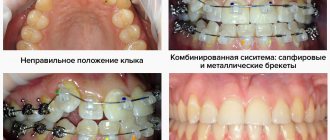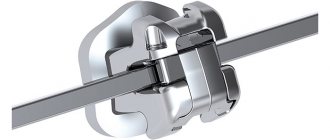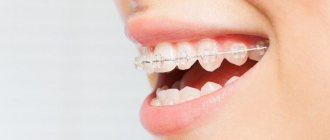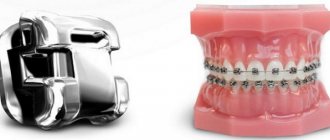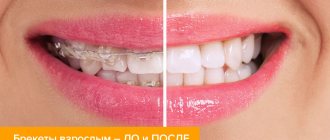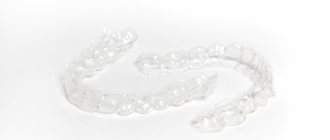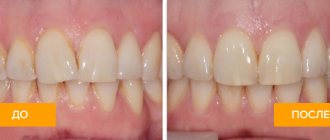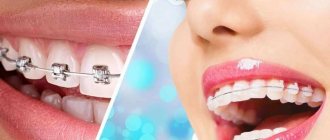Excursion into history | Ligature and self-ligating constructions | Biomechanics of tooth movement | System installation | Stages of treatment | Lingual and vestibular structures
Braces are locks fixed to the teeth with a groove and “wings”. The principle of operation of the system is the ability of the orthodontic arch to return to its original position. The straightening archwire puts pressure on the braces, causing the teeth to move. Fixed retainers and aligners stabilize the results obtained at the final stage of treatment.
The material was verified by Anna Rimkevich, senior product manager at Ormco Russia.
The basis of bite correction is the mechanism of action of weak forces and the movement of teeth in accordance with the bends and shape of the arch. The metal arch has “shape memory”: it straightens, pulls the braces along with it and moves the teeth in the desired direction. The formation and destruction of bone tissue is part of the natural process of tooth movement. The principle of operation of braces allows you to achieve the goal of orthodontic treatment - to create the best balance of occlusion, facial aesthetics and dentition.
Damon Clear with orthodontic arch
Excursion into history
At the beginning of the 20th century, the American doctor Edward Engle created the first prototype of the braces system and called it the Engle apparatus. Angle's apparatus consisted of an elastic stainless steel arc and ligature elements. The arc was tightly fixed in the tubes. The tubes were soldered to orthodontic rings placed on the first molars. Each tooth was tied to an arch curved in the shape of the dentition with a ligature wire.
Subsequently, the scientist significantly changed the original design and developed the edgewise technique. Orthodontic locks, edgewise, were a rectangular piece with a groove. An arc was inserted into the groove and the lock was locked with a pin. Subsequently, the design of braces was modified: orthodontic arches with a square and rectangular cross-section profile, with sharp and rounded edges, appeared.
Later, the edgewise technique was further modified by doctors. Thanks to the active development of orthodontics in the 20th century, the modern operating principle of braces was formed. Today, the doctor is offered various options for torque and angulation. Torque (or inclination) is the deviation of a tooth from its axis in the vestibulo-oral direction. Angulation is the deviation of the tooth in the mesio-distal direction. Taking into account torque and angulation allows, based on a specific clinical case, to individually select the optimal brace option for each tooth.
Activation steps
The process of activating braces consists of several stages, but they are not carried out all at the same time at each visit to the doctor, but only as needed. Here are the elements that need to be replaced regularly:
- Ligatures. As a rule, these are elastic bands that secure the bracket to the arch. Over time, they lose elasticity, and the pressure on the teeth weakens, which slows down the correction process. Timely replacement of rubber bands allows you to once again enhance the effectiveness of the braces system.
- Arc. Under the influence of the system, the overall geometry of the dental row changes. At the same time, the bending of the metal arc becomes less pronounced; it begins to protrude forward, causing inconvenience. The doctor replaces it as needed, restoring the pressure on the teeth.
- Braces. It happens that they are damaged by careless mechanical action and become detached from the tooth - in such cases, they require reconstruction or complete replacement.
During each patient visit to activate braces, the doctor evaluates whether the correction is occurring correctly and whether the teeth are moving in the desired direction. Ligatures require the most frequent replacement, arches are adjusted less frequently, and braces may not need to be replaced at all for the entire period of wear if there is no damage.
Construction of braces: comparison of non-ligating and self-ligating structures
There are ligature and self-ligating devices. The first includes traditional designs: the arc is fixed in the groove using elastic or wire ligatures. Example: Mini Diamond, Inspire Ice, Orthos devices. Ligature systems are characterized by a long treatment period - from one to three years, depending on the complexity of the clinical case, lengthy adaptation and labor-intensive hygienic care. Activate the device: replace arches and ligatures, it is necessary on average once a month, and sometimes more often.
traditional construction with ligatures
ligature Mini Diamond
The design of self-ligating braces has a fundamental difference: the system works without ligatures. Consists of a groove and a closing lid. The orthodontic arch slides in the groove. Ligature-free designs provide a reduction in treatment time compared to ligature devices by an average of 7 months. Less painful during the adaptation stage and easier from the point of view of oral hygiene. They turn out to be the option of choice in many clinical cases. The entire line of Damon System braces are self-ligating.
self-ligating Damon Q2
How does a braces system without ligatures work? The principle of operation of non-ligation devices is divided into passive and active self-ligation. With the passive type of fixation, the arc moves freely in the groove. The cover holds the arc and does not put pressure on it. Example: Damon Q, Damon Clear. With the active type of self-ligation, the clip presses on the arch and moves it to the base of the groove. Activation of self-ligating systems is carried out once every 2-3 months.
system without ligatures
Damon Clear and Q on typodont
Braces are made from various materials. Ligature and self-ligating structures are made of metal, transparent polycrystalline aluminum (ceramics), plastic and artificially grown sapphire. Metal braces, for example, Damon Q and Damon 3 MX, are the most durable. The Damon Clear2 ceramic and sapphire Inspire Ice models have the best aesthetic characteristics.
metal Damon Q2
ceramic Damon Clear
The orthodontist and the patient jointly overcome the path to high aesthetic smiles and a healthy dental system. Regardless of the type of braces and manufacturing material, the combination of the orthodontist’s professionalism with a high degree of patient responsibility allows one to achieve stable results in the treatment of malocclusions.
Third stage: consolidation of results
The retention period (aka recovery period) is also quite important in the overall treatment complex. You shouldn’t breathe a sigh of relief because you got rid of braces; this is far from the end of your treatment. If you suddenly stop putting a lot of stress on your teeth, they will try to return to their original state. To prevent this, it is necessary to wear protective retainers for several months or even years. They can be removable (using custom-made aligners) or permanent (like thin rubber splints or lingual braces attached to the inside of the tooth).
EXPERT OPINION
, work experience:
Correction of bite with internal braces INCOGNITO - RUB 350,000!
All inclusive! Preparation and treatment of the oral cavity, consultation with an orthodontic specialist, installation and adjustment of orthodontic structures. The price is for 1 jaw. Consultation with a doctor is free! Call now: +7 (495) 789-39-31
The final result depends not only on the doctor, but also on the patient himself. Firstly, he must remember to regularly visit the orthodontist (after all, braces need to be tightened in order to constantly increase pressure on the teeth, which are gradually changing their position). Secondly, you need to strictly follow all the doctor’s recommendations regarding lifestyle, nutrition and, most importantly, hygienic oral care.
Price
| Service name | Price |
| Self-ligating braces Damon Q (Ormco, USA) | 110,000 rub. |
| Inspire Ice (Ormco, USA) | 110,000 rub. |
| Self-ligating Damon Clear (Ormco, USA) | 120,000 rub. |
All prices for services
Biomechanics of tooth movement
To understand how braces work, let’s look at the biological and physiological processes that occur during tooth movement. The teeth are located in the alveoli - natural depressions in the jaw bones of the skull. The root of each tooth is surrounded by periodontal fibers that hold the tooth in the socket. The fibers also perform a shock-absorbing function: they allow the tooth to make micro-movements in all directions. After fixing the bracket and installing the arch, force begins to act on the root of the tooth. To move teeth slowly and less painfully, a weak and prolonged force is applied.
Due to the movement of the tooth root, there is a need to free up space in the alveolus. To do this, osteoclasts begin to destroy the bone where the root touches the alveolar wall. Osteoclasts are special cells that remove bone tissue. On the opposite side, osteoblasts produce new bone to fill the vacated space. Under the influence of osteoclasts and osteoblasts, the balance of formation and destruction of bone tissue ensures the progressive movement of teeth.
Installation of braces
A general understanding of how dental braces work, the design and installation process of the system is important for everyone. There are two installation options: direct and indirect method.
The direct method involves manually installing and positioning each bracket on a tooth directly in the patient’s mouth. Fixation is carried out on a light-curing material. The indirect method involves positioning the system on a plaster model. The braces are transferred from the model to the mouthguard. The mouthguard is formed individually for each patient. Next, glue is applied, the mouthguard is put on the teeth, and the braces are fixed in a predetermined position for each jaw in turn.
Stages of treatment
The first stage is preparation for orthodontic treatment. Preparation includes x-ray diagnostics, sanitation of the oral cavity and removal of the required number of teeth.
The second stage involves fixing the structure. An initial thin arch with a round cross-section profile is installed. Further in the treatment process, the doctor changes the arcs from a smaller cross-sectional diameter to a larger one. At the final stages, rectangular rigid arches are used.
On average, it is necessary to visit a doctor from once a month when treating with ligature models to once every 2-2.5 months when treating with self-ligating systems. At the end of the second stage of treatment, the doctor removes the braces using enamel-safe forceps. The remaining adhesive is removed from the surface of the teeth with a low-abrasive bur, and the tooth is polished with a brush using a polishing paste.
The third stage is the retention period. The results of orthodontic treatment are stabilized with the help of permanent retainers and aligners.
The duration of treatment depends on the complexity of the anomaly being corrected, the individual anatomical characteristics of the patient and the professionalism of the orthodontist. The speed of tooth movement is influenced by the design of the brace: self-ligating systems can provide faster results in 1-2 years. Treatment with ligature models lasts on average 2 to 3 years.
Some dental anomalies are corrected using removable hard aligners. When treated with aligners, the patient is given a set of several rigid aligners that differ in shape. The patient changes the aligners independently every two weeks. Once every month and a half, the patient visits the orthodontist to assess the progress of treatment. Mouthguards are worn constantly: the device is removed only when eating and brushing teeth.
Stage No. 7. Installation of retainers
Retainers are a group of orthodontic devices that are placed after braces are removed to secure the result.
The shape of the retainer is selected individually, as well as the material - polymer or metal and the method of attachment - removable or non-removable. Retainers are installed after professional teeth cleaning. The process takes about 15 minutes.
The duration of the retention period is different for everyone, and can range from 8 months to 5-6 years. You can talk about reducing the length of time you wear a retainer after control visits to the orthodontist every six months.
The author of the article is an orthodontist, Olga Vladimirovna Chugunova.
Comparison of lingual and vestibular constructions
Based on their location in the dental cavity, they are divided into lingual and vestibular systems. The vestibular position on the outer side of the dentition is classic and is used in the vast majority of cases.
Vestibular Mini Diamond
Lingual appliances are installed by patients with the highest aesthetic requirements. Adaptation to internal systems is more difficult compared to vestibular structures. The principle of operation of lingual and vestibular braces is not fundamentally different: in both cases, the arch is straightened and exerts a force on the braces, leading to the movement of teeth. If there is excessive crowding, the use of a lingual system is not recommended. The duration of treatment on the lingual structure is slightly longer than on the vestibular one. The patient sometimes experiences additional discomfort due to the interaction of the tongue with the brace system.
lingual braces STb
What is better - ligature or self-ligating braces?
Having considered the pros and cons of self-ligating braces, you can make the right decision - the dentist will definitely tell you about possible correction options; the final choice depends on the characteristics of the bite. Ligature-free braces look more attractive, can significantly increase the effectiveness of bite correction, reduce the treatment period by 20-25%, reduce the trauma of the bite correction process - the tissues are not overloaded, and the mucous membranes and periodontium quickly adapt to the movement of teeth. Correction of non-ligature systems takes no more than 15 minutes.
The main disadvantage of non-ligature braces is their high cost. And this is one of the reasons for the popularity of ligature systems, especially among teenagers and young adults. In addition, ligatures make it possible to use different colors of ligatures and make the braces system a kind of accessory - to emphasize style and individuality. Finally, ligature systems also have strict orthodontic indications.
When choosing a system for occlusion correction, both dentists and patients are usually guided by indications, but it is important to take into account all the wishes and financial capabilities of the patient. And remember that both ligature and non-ligature braces will help you achieve the desired result - straight teeth and a healthy bite; in this they are equally effective.
Installation of veneers
Veneers are porcelain or composite plates that replace the outer thin layer of a tooth.
Effectively correct dental discoloration, cover cracks or stains due to enamel hypoplasia. Veneers are an aesthetic solution and do not replace orthodontic treatment. Unlike veneers, braces move teeth. Treatment with braces ensures the formation of an aesthetically correct smile, restoration of the physiological bite and function of the dental system. The material is for informational purposes only and is presented for informational purposes. It does not replace consultation with an orthodontist and is not a guide to correcting dental anomalies.
When is orthodontic treatment with braces necessary?
A good reason to seek orthodontic treatment may be:
- Ugly smile, crooked teeth.
- Functional disorders of the dental system that worsen the patient’s quality of life: there is no ability to bite or chew well, teeth are destroyed and worn out.
- Problem with the jaw from overload of the temporomandibular joint (TMJ).
- Lack of space for prosthetics due to deformation of the dentition.
But it happens that the patient himself does not see the reasons for orthodontic treatment, and his dentist sends the patient to an orthodontist. Why?
Because his correct interdental contacts are impaired. The patient may not be aware of this; he is satisfied with the smile and is not bothered by anything. But the dentist sees the issue at the level of functioning of the dental system. If the teeth do not close properly, this means that the chewing load on the teeth is distributed unevenly. Sooner or later this will lead to illness. Timely orthodontic treatment is the only way to maintain healthy teeth for the rest of your life.
